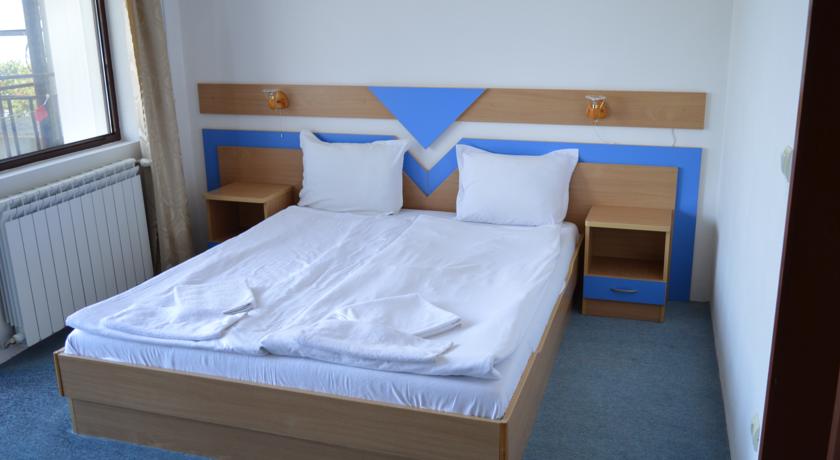Nessebar - a small piece of land embraced by the sea, tied with a narrow rope-like neck to the quay of the continent.
The time and waves were merciful and have left us, the descendants, this marvelous creation of the nature, together with the ruins of the built by our ancestors architectural inheritance.The town is situated southwards of the last branches of the ancient Hemus Mountain (today’s Stara Planina), which gradually lower to the Black Sea and at Cape Emine their rocks touch the water.
The old town is long only 850 m and is 350 m wide. During the different periods of its existence it has lost 1/3 of its territory, which sank into the sea. Under the water, 80 meters away from the coast still can be seen remains of the fortress’s walls.
At present is preserved only the western wall with the gate, which defended the town from the mainland. The Nesebur Peninsula - the ancient Mesambria, which was called Mesemvria in the Early Middle Ages and later - Nesebur, was populated more than three millenniums ago, at the end of the Bronze Age. The ancient Thracians named it Melsambria, what in their language means “the town of Melsa” - the legendary founder of the settlement. Melsambria has had two convenient harbours - a northern and a southern one, in which still are being found remains of the ancient ships’ equipment.
About the end of the 6th B.C. century, the first Greek colonizers arrived in the settlement - they were Dorians by origin. The settlement was gradually fortified; temples, gymnasium and theater were built. The settlement transformed itself in a classical polis - a town with the respective structure, functions and administration.
In the town were built ships, a number of handicrafts was developed - mainly processing of metal. Mesambria began making own coins around 440 B.C.
The town has reached its boom during the 3rd-2nd B.C. centuries when also gold coins were emitted. It maintained busy trade relations with the towns along the Black and Aegean Seas, as well as those on the Mediterranean coast. The numerous findings from that period, exhibited in the town’s Archeological Museum, are material expression of the rich economic, cultural and spiritual life of the town.
In 72 B.C. the town was conquered without resistance by the Roman army. After a short period of occupation, about the beginning of the 1st A.D. century, it was permanently included in the Roman Empire. Mesembria, as it was called at this time, has preserved untouched its fortress walls and the big public buildings. It kept making own bronze coins and remained an important commercial and cultural center on the Black Sea coast of the Roman Thrace. The high cultural level reached by the town is visible from findings as the base of the bronze statue of Emperor Claudius, preserved parts of marble embossments, inscriptions and statues.
After the capital of the Roman Empire was moved to Constantinople and Christianity was adopted as an official religion, favourable conditions for the revival of the Black-Sea towns were created. In Mesemvria were built new Christian temples -basilicas; fortress walls were erected, new water-supply system and town’s termas were built. All that construction work was performed under the supervision of leading empire’s architects and builders, following the pattern of the capital’s prototypes.
The central church of Mesemvria bears the name Sveta Sofia (St. Sofia), as it is in Constantinople.
The impressive building still rises in a central place of the town, giving shelter to summer cultural appearances and providing exhibition area to many artists. During the time of the first Bulgarian state Mesemvria is a town often mentioned in the medieval sources as a cross-point of the Bulgarian-Byzantine relationships. For example, Emperor Constantine, who was completely defeated in the battle at Ongula by the Bulgarian Khan Asparouh, arrived in the town to cure his gout. Most probably he was taking water cure in the recently found by the archeologists termas. In A.D. 705 the future Byzantine emperor Leo the Syrian, traveling to Constantinople, meets in Mesemvria the Bulgarian Khan Tervel and his army.
For the first time the town was included in the borders of the Bulgarian state in A.D. 812, when Khan Kroum conquered the town by assault. Slavs and Bulgarians populated the settlement. The town was controlled again by Bulgarians and for a longer period in the reign of Tsar Simeon the Great.
During the 12th and 13th centuries the town developed active trade relations with the lands of the Mediterranean and Adriatic, as well as with the principalities situated to the north of Danube River. The churches “Sveti Stefan” (St. Stefan) -11th century and “Sveti Yoan Krustitel” (St. John the Baptist) - 12th century, were built and mural-painted. They became prototypes of the later masterpiece Nesebur churches of the 13th-14th c.
In the course of 62 years, from 1201 till 1263, the towns along the Black Sea coast, situated to the south of Balkan Mountain, including Nesebur, were lastingly included in the borders of the Bulgarian state. The town had a significant role in the political history of Bulgaria and Byzantium during the time when on the throne were sitting the Bulgarian Tsars Kaloyan, Ivan Asen II and Konstantin Tih. During this time were built the churches “Sveta Petka” (Paraskeva) - 13th century, “Sveti Todor” - 14th century, “Sveti Archangeli Mihail and Gavrail” (St. Archangels Mihail and Gavrail) - 14th century, which have direct analogues in the architecture of the capital Turnovo. Nesebur has maintained active trade relations with Constantinople, Venice, Genoa, Pisa, Ancona, Dubrovnik and other towns. After a period of about 40 years, during which Nesebur was ruled by Byzantium, it was again integrated with the Bulgarian state by Tsar Todor Svetoslav.
The town enjoyed especial boom during the reign of Tsar Ivan Alexander. New churches were built - “Hristos Pantokrator” (Christ Almighty) - 13th century, “Sveti Yoan Neosveteni” (St. John Undedicated) - 14th century; many monasteries carried on active spiritual activities in the surroundings of the town - “Sveta Bogoroditsa” (Holy Virgin), “Hristos Akropolit”, “Sveti Petar”, “Sveti Andrei”, “Sveti Iliya”, “Sveti Vlasii”, “Sveti Nikola Emonski”, which were centres of the hesychasm in Bulgaria. Here were educated also the future Bulgarian patriarchs. The family of the Tsar, and the Tsar himself, granted a series of privileges to the Nesebur monasteries and gave them rich donations.
According the legends, during his existence Nesebur had about 40 churches. At present are available data for 26 of them.
Now, owing to the big number of well preserved churches, especially from the period 13th-14th centuries, the town is called by our and foreign researchers the Bulgarian Ravenna. During almost the entire history of the town, Nesebur was the seat of a bishop. Owing to this, two of the churches in Nesebur - “Sveta Sofia” and “Sveti Stefan” are more known as the Old Metropolis and New Metropolis.
In 1366 the town was conquered by the knights of Count Amedei of Savoya and later turned over to the Byzantine Emperor.
For the first time the town was conquered by the Ottomans in 1396. It has fallen completely under the Ottoman rule, together with the capital Constantinople, in 1453.
Representatives of highborn families remained to live in Nesebur. From that time - year 1441 - is the exhibited in the Archeological Museum gravestone of the Byzantine princess Mataisa, descendant of two emperor families - the Palaeologs and the Kantakouzens.
This plate was the lid of a sarcophagus placed in a tomb, which was built in one of the arches of the “Old Metropolis”.
During the centuries of the Ottoman rule the economic and spiritual life did not stop. Churches were constructed and mural-painted; icons were prepared.
The Nesebur’s harbour continued to be a main import and export center on the Black Sea coast. Until the 17th-19th centuries some of the Nesebur’s monasteries and their scriptoria were still operative.
From the epoch of the Bulgarian Renaissance in Nesebur remained quite many houses, typical representatives of the Black-Sea house and some of the windmills that have worked earlier in the town, a public bath and fountains for drinking water. Since the end of the last century Nesebur is a small town, the main means of living being fishing and agriculture - mainly vine-growing and flax-growing. After 1959, when the resort complex “Slunchev Bryag” (Sunny Beach) was built, international tourism is being developed in the town and the surroundings.
The cultural inheritance of the ancient town is presented in four museum expositions:
- The Archeological Museum, which presents the rich material culture of Mesambria - Mesemvria - Nesebur, from the Antiquity, the Middle Ages and the Renaissance.
- The Ethnographic Museum - the “Moskoyani” house.
- The church “Sveti Stefan” - 11th century - 16th century frescoes and an iconostasis from the 17th century.






